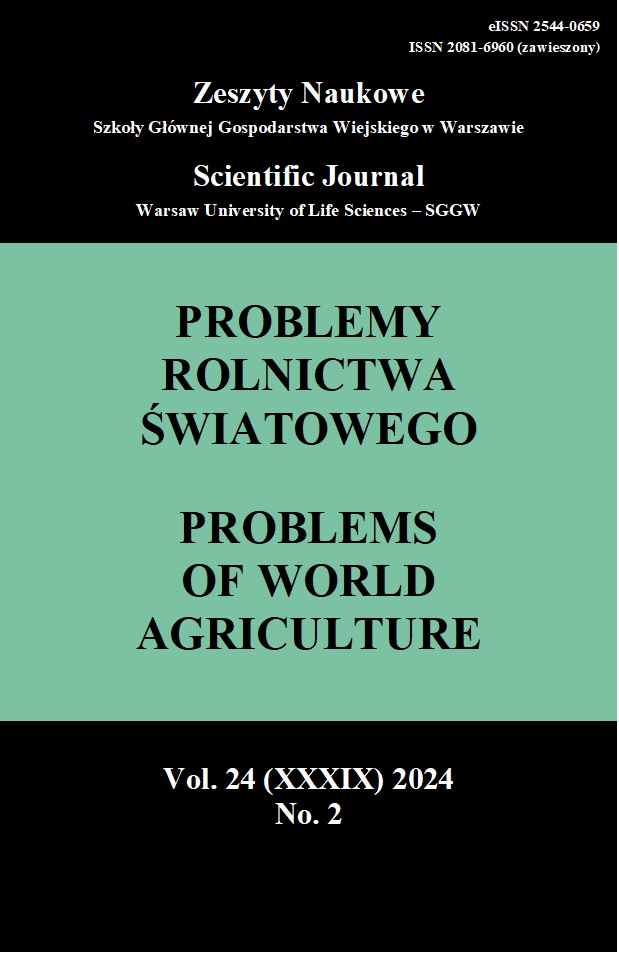Main Article Content
Article Details
Bejaei M., Wiseman K., Cheng K.M. (2011). Influences of demographic characteristics, attitudes, and preferences of consumers on table egg consumption in British Columbia, Canada. Poultry Science, 90(5), 1088-1095. doi: 10.3382/ps.2010-01129. (Crossref)
Clark B., Stewart, G.B., Panzone, L., Kyriazakis I., Frewer, L.J. (2017). Citizens, consumers and farm animal welfare: A meta-analysis of willingness-to-pay studies. Food Policy, 68(C), 112-127 https://doi.org/10.1016/j.foodpol.2017.01.006. (Crossref)
Cornish, A., Raubenheimer, D., McGreevy, P. (2016). What We Know about the Public's Level of Concern for Farm Animal Welfare in Food Production in Developed Countries. Animals, 6(11);74. doi: 10.3390/ani6110074 (Crossref)
Estévez-Moreno, L.X., Miranda-de la Lama, G.C., Miguel-Pacheco, G.G. (2022). Consumer attitudes towards farm animal welfare in Argentina, Chile, Colombia, Ecuador, Peru and Bolivia: A segmentation-based study. Meat Science, 187, 108747. doi: 10.1016/j.meatsci.2022.108747. (Crossref)
Eurobarometer (2005, May). Attitudes of Europeans towards animal welfare. European Commission. Retrieved from: https://europa.eu/eurobarometer/surveys/detail/450
Eurobarometer (2016, March) Attitudes of Europeans towards animal welfare. European Commission. Retrieved from: https://europa.eu/eurobarometer/surveys/detail/2096
Fonseca, R.P., Sanchez-Sabate, R. (2022). Consumers' Attitudes towards Animal Suffering: A Systematic Review on Awareness, Willingness and Dietary Change. International Journal of Environmental Research and Public Health, 19(23), 16372. doi: 10.3390/ijerph192316372. (Crossref)
Goldberg, A.M. (2016). Farm Animal Welfare and Human Health. Current Environmental Health Reports, 3(3), 313-321. (Crossref)
Blokhuis, H.J., Keeling, L.J., Gavinelli, A., Serratosa J. (2008). Animal welfare's impact on the food chain. Trends in Food Science & Technology, 19(1), 79-87. https://doi.org/10.1016/j.tifs.2008.09.007. (Crossref)
Kjaernes, U., Miele, M., Roex, J. (2007). Attitudes of Consumers, Retailers and Producers to Farm Animal Welfare Welfare Quality® Reports 2.
Lusk, J.L., Norwood, F.B. (2009). Bridging the gap between laboratory experiments and naturally occurring markets: An inferred valuation method. Journal of Environmental Economics and Management, 58(2), 236 250. (Crossref)
Malek, L., Umberger, W.J., Rolfe, J. (2018). Segmentation of Australian meat consumers on the basis of attitudes regarding farm animal welfare and the environmental impact of meat production. Animal Production Science, 58(3), 424-434. (Crossref)
McKendree, M.G., Croney, C.C., Widmar, N.J. (2014). Effects of demographic factors and information sources on United States consumer perceptions of animal welfare. Journal of Animal Science, 92(7), 3161-3173. doi: 10.2527/jas.2014-6874. (Crossref)
Miranda-de la Lama, G.C., Estévez-Moreno, L.X., Sepúlveda, W.S., Estrada-Chavero, M.C., Rayas-Amor, A.A., Villarroel, M., María, G.A. (2017). Mexican consumers' perceptions and attitudes towards farm animal welfare and willingness to pay for welfare friendly meat products. Meat Science, 125, 106-113. doi: 10.1016/j.meatsci.2016.12.001. (Crossref)
Pasquale, J., Nannoni, E., Duca, I., Adinolfi, F., Capitanio, F., Sardi, L., Vitali, M., Martelli, G. (2014). What Foods are Identified as Animal Friendly by Italian Consumers? Italian Journal of Animal Science, 13, 3582, DOI: 10.4081/ijas.2014.3582. (Crossref)
Pension Fund of Ukraine (2023, November 27). Average salary indicator for 2023. Retrieved from: https://www.pfu.gov.ua/2158510-pokaznyk-serednoyi-zarobitnoyi-platy-za-2023-rik/
Petkun, H.V., Nedosekov, V.V. (2022). Analysis of EU and Ukrainian legislation for the cattle welfare. Scientific Messenger of LNU of Veterinary Medicine and Biotechnologies. Series: Veterinary Sciences, 24(106), 108 113. doi: 10.32718/nvlvet10617. (Crossref)
Rating (2020, March). Sociological group The role of women in Ukrainian society (in Ukrainian). Retrieved from: https://ratinggroup.ua/files/ratinggroup/reg_files/rg_women_032020_press.pdf.
Regan, Á., Henchion, M., McIntyre, B. (2018). Ethical, moral and social dimensions in farm production practices: A segmentation study to assess Irish consumers’ perceptions of meat quality. Irish Journal of Agricultural and Food Research, 57, 9-14. (Crossref)
Rubini, G., Nannoni, E., Di Pasquale, J., Martelli, G., Sardi, L. (2021). Update on animal welfare perception by Italian consumers: A descriptive survey. Italian Journal of Food Safety, 29, 10(3), 9588. doi: 10.4081/ijfs.2021.9588. (Crossref)
Schröder, M.J.A., McEachern, M.G. (2004). Consumer value conflicts surrounding ethical food purchase decisions: A focus on animalwelfare. International Journal of Consumer Studies, 28, 168-177. https://doi.org/10.1111/j.1470-6431.2003.00357.x. (Crossref)
Spooner, J.M., Schuppli, C.A., Fraser, D. (2014). Attitudes of Canadian pig producers toward animal welfare. Journal of Agricultural and Environmental Ethics, 27(4), 569-589. (Crossref)
Sweeney, S., Regan, Á., McKernan, C., Benson, T., Hanlon, A., Dean, M. (2022). Current Consumer Perceptions of Animal Welfare across Different Farming Sectors on the Island of Ireland. Animals, 12(2), 185. doi: 10.3390/ani12020185. (Crossref)
Wolf, C.A., Tonsor, G.T., McKendree, M.G.S., Thomson, D.U., Swanson, J.C. (2016). Public and farmer perceptions of dairy cattle welfare in the United States. Journal of Dairy Science, 99(7), 5892-5903. doi: 10.3168/jds.2015-10619. (Crossref)
Downloads

Utwór dostępny jest na licencji Creative Commons Uznanie autorstwa – Użycie niekomercyjne 4.0 Międzynarodowe.





